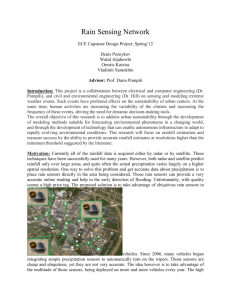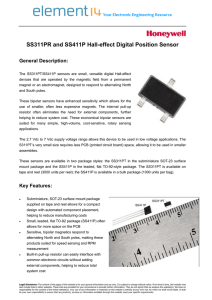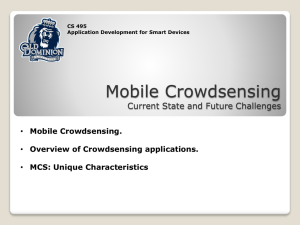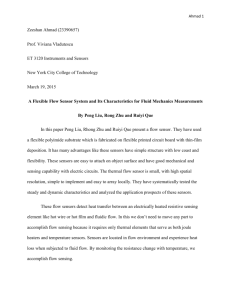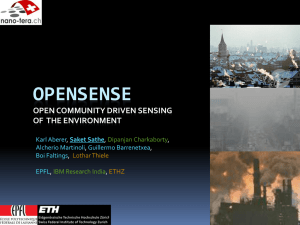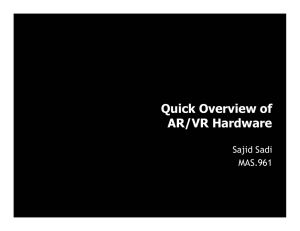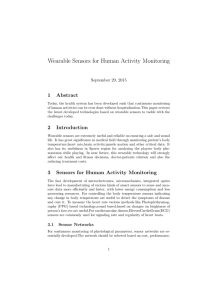slides
advertisement
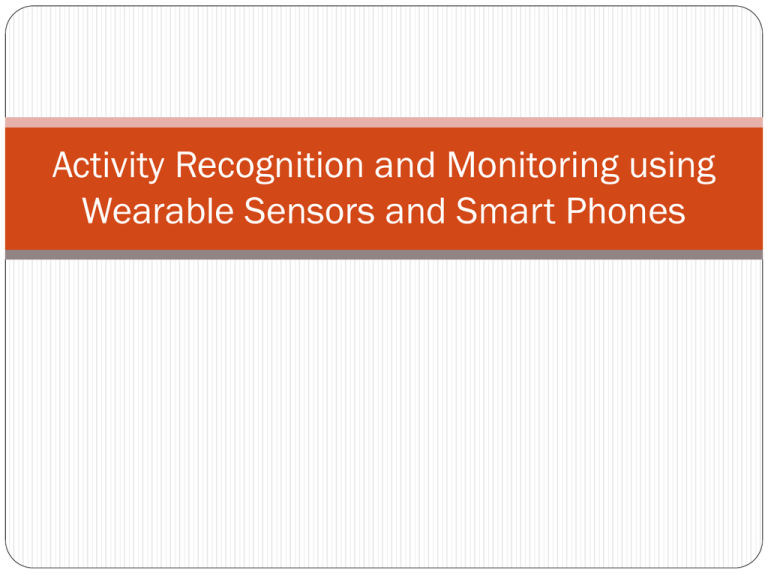
Activity Recognition and Monitoring using Wearable Sensors and Smart Phones Outline Activity recognition applications Under the hood of activity recognition Existing activity recognition systems Further design considerations Activity Recognition (AR) AR identifies the activity a user performs Running, walking, sitting … Provides important context in addition to locations Dedicated sensors or smart phones End-user Applications Fitness tracking Distance traveled Intensity and duration of activity Calories burned Health monitoring Allows long-term monitoring and diagnosis using continuously generated data, e.g., Parkinson disease Changes in behavior patterns can be telling Positive feedback to ratify behaviors, e.g., reducing hyperactivity via feedback actigraph Fall detection End-user Applications Context-aware behavior Customized device behavior, e.g., Playing different kinds of music based on the activity level Changing display fonts based on moving speed Manage device resource based on user activities, e.g., reduce GPS sampling interval when users are stationary Home and work automation Third-party Applications Targeted advertising Inferring interest categories, e.g., a person visits Chinese restaurants a lot (but not working there) Adapting to present context, e.g., when and how to display ads based on user activities Corporate management and accounting Mandatory AR, e.g., monitoring whereabout and activities of hospital staffs Voluntary AR, e.g., car insurance tied to driving behavior Applications for Crowds and Groups Enhancing traditional social networks, e.g., uploading activity information such as jogging Discovery friends based on common activities in close proximity Tag places based on activities or detect changes Basic AR System Diagram Attributes and Sensors Environmental attributes Temperature, humidity, audio level … Providing contextual information Acceleration Triaxial accelerometers > 90% accuracy for ambulatory activities Eating, tooth brushing, and working on a computer more difficult to distinguish, and is dependent on the location of the sensor Location Physiological signals: vital signs Feature Extraction Acceleration Environment variables Vital signals Structural features better capture the “trend” E.g., Coefficients of fitting polynomial Classification Supervised classification Semi-supervised classification Supervised Online AR Systems Online classification of activities Supervised Offline AR Systems Gathered data analyzed offline Applications: calorie burned over a day System Issues on Implementing AR in Smart Phones Multiple sensors on a single platform have different characteristics/requirements Accelerometer sensitive to orientation but incurs little computation costs Acoustic sensor robust to positions but has high computation cost to process GPS has high energy cost for continuous sensing Modular design allowing incorporation of new signal processing algorithms Flexible programming model in building new applications Jigsaw – A continuous sensing engine Code in the air (CITA) Tasking framework: developers write task scripts and compile to server and mobile codes Activity layer: high level abstraction allowing activity composition such as isBiking Push service: communicates between devices & server Activity Composition Support AND, OR, NOT Event A WITHIN xx sec Event A for xx sec Event A next B Ex: Alice wants her phone to be silent if she is in meeting room with her colleague Bob or Alex If Alice in the meeting room Bob is the meeting room and Alex is in the meeting room Challenges and Opportunities “Open” problems: Individual characteristics (age, gender, height, weight…) affects the accuracy of AR Concurrent/overlapping movements Composite activities: playing tennis Interesting directions: Collective activity recognition Prediction of future activities Reference J. Lockhart, T. Pulickal, and G. Weiss, Applications of Mobile Activity Recognition Oscar D. Lara and Miguel A. Labrador, A Survey on Human Activity Recognition using Wearable Sensors Hong Lu,Jun Yang Zhigang Liu Nicholas D. Lane, Tanzeem Choudhury,Andrew T. Campbell, The Jigsaw Continuous Sensing Engine for Mobile Phone Applications Lenin Ravindranath, Arvind Thiagarajan, Hari Balakrishnan, and Samuel Madden, Code In The Air: Simplifying Sensing and Coordination Tasks on Smartphones



